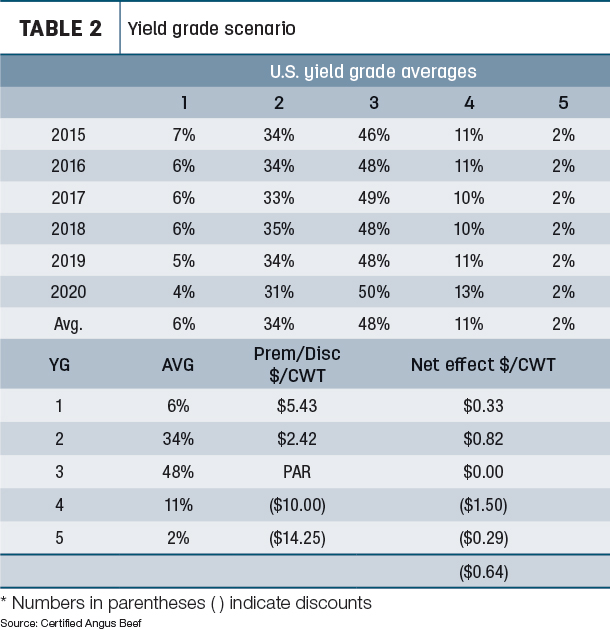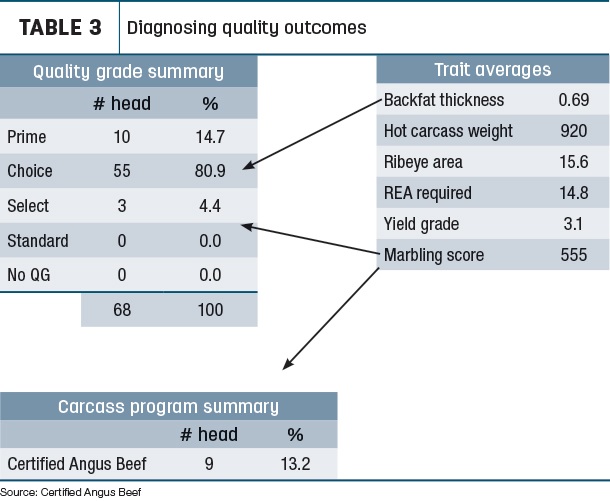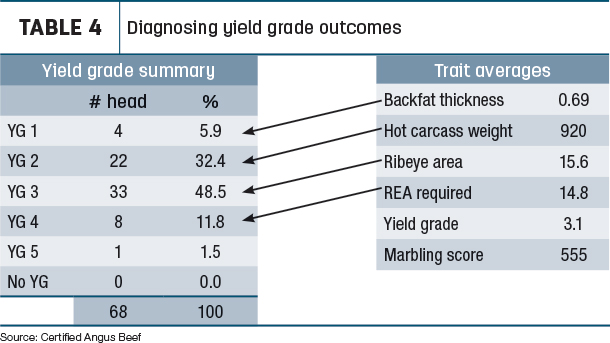Cattle producers who work the marketing grid premiums know every detail counts, both in their cattle and their bottom line.But the high-value strategy is always laced with one key truth – there are still no guarantees.
Speaking in a January webinar on grid marketing and carcass data, Paul Dykstra, assistant director of supply management and analysis for Certified Angus Beef and author of the CAB Insider blog, outlined key objectives in grid marketing.
Key goals on the grid are to increase net return, seizing upon seasonal opportunities in the market, and to recapture input costs on high-quality carcass traits.
Those factors can commonly work to producers’ advantage. But the caveat always exists to avoid unrealistic expectations.
“We need to be really honest with ourselves that grid marketing is not the salvation if cattle markets are poor,” Dykstra explained. “We might achieve a better return on the bottom line of our closeout. But if the market hands us an unfortunate deal, then we’re going to have to deal with that, and selling on the grid will not fix all things that might occur.
Grid starting points
Grid marketing first builds upon the two methods used to determine a flat price – live weight or carcass weight.
Live weight is where cattle sold are picked up by buyers or sold free on board (f.o.b.) by the feedlot to packers. Cattle are weighed on scales at feedlot, with a shrink of 4% to 5% penciled in, depending on the region or what day they are sent. Dykstra said the method is more common in arid regions where mud is less a factor.
Carcass weight is where feeders are paid on a hot carcass weight. It is primarily used in southeastern or northern regions where mud is a factor, and sensitive to dressing percentage.
The grid marketing then uses a formula, contract or spot market bid, and has been used more commonly by packers in recent months. This method incorporates live price or carcass price comparisons but factors in the impact of dressing percentage, which typically is 62% to 63%.
“We need to realize we could be taking up some advantage or giving up some advantage depending on when we make that decision,” Dykstra said. “If the cattle don’t yield well, then we’ll be starting behind the eight ball. When cattle are exceptional in terms of muscling, then they may have an advantage and move us up in the truck.”
Those factors that can affect dressing percentage include mud, gut fill, external fat, muscling, gender (with steers having higher dressing percentage than heifers) and age (yearlings dress less than older cattle).
External fat has two edges to it, Dykstra explained. “Additional external fat is positive to dressing percentage. It adds weight to the carcass to increase carcass yield as a percent of live weight. After this fact, of course, it becomes detrimental to yield grade, meaning the percentage of closely trimmed retail cuts; the latter measure being a measure of red meat yield as a percentage of carcass weight.”
The guiding principle on the grid stands that you can make up lower dressing percentage with a higher percentage of premiums. “All is not lost if cattle do not dress well,” Dykstra said.
The top target of quality grade and yield grades, Prime Yield Grade 1’s, have long been the brass ring for producers working the grid for highest premiums.
Quality grade carcasses
Dykstra showed graphs indicating how 10% of all carcasses in 2020 averaged Prime grade quality – up from 5% in 2010. That volume has maintained a popular motivation for Prime carcasses to reap on average $14.06 per hundredweight (see Table 1) in the past six years.

Carcasses qualifying for CAB premiums are selected as a proposition of those grading between Prime and Choice, and the acceptance rate has steadily risen from 14% in 2006 to 36% in 2020.
“That’s really a massive improvement in sales volume for our brand. The premiums for the CAB have remained strong and improved. So even as we add more and more tonnage in sales to the product, we still have packers willing to incentivize to a higher degree than they did when supplies were low. That’s a trend we like to see a lot.”
But Prime premiums dropped from $13.98 in 2019 to $10.80 in 2020, which was caused primarily by the lack of restaurant service during the pandemic.
“The supply of higher-grade carcasses is growing and growing,” Dykstra said. “Especially in ’19 and ’20, the industry had more than it could manage. As restaurants come back online in the near future, and more retailers are capitalizing on the Prime grade, I think these premiums for Prime will stay healthy and will stabilize and increase. Down the road we’ll just get more of the ability to utilize that Prime product.”
To gauge the demand and supply of those high-quality carcasses, the market watches the Choice-Select spread. Dykstra said there’s a strong seasonal trend for Choice over Select in spring and late fall. But producers shouldn’t be under the false illusion that it is a static price point.
“The Choice-Select spread is not something that every Choice carcass receives the full weight of,” he said. “That’s something that’s difficult for some to understand.”
To determine a common Choice-Select spread premium formula, Dykstra explained that if a plant has a 70% Choice average, and the Choice-Select spread is at $10 per hundredweight (cwt), a formula of 100% minus 70% plant average = 30%. Multiply 30% by $10 per cwt, which equals a $3 per cwt. Therefore every Choice carcass would receive a $3-per-cwt premium.
Yield grade carcasses
Compared to quality grades, the yield grade is “something we don’t talk about enough in the industry.”
Yield Grade 1 remains the primary target with the right balance of thin external fat over the loin and rib. Packers are always willing to pay more for Yield Grade 1, with last year’s grid price per cwt hitting $5.43.
“Remember, only about 20 percent of the fed steers are receiving a USDA yield grade because packers are not pricing carcasses based on yield grade that they sell to customers.
“However, we do use camera grading to capture yield grade for payment purposes. They still have the cameras to capture it.”
The issue with targeting yield grade, Dykstra explained, has been the growing trend for heavier weights. In 2020, the issue was compacted by longer wait times in the feedlot as the industry worked through a backlog of supply.
“What we’ve achieved in this country across the fed cattle sector since 2000, we’re achieving a fatter end point today than we were in 2000,” he said.
“We have an annual average that reads pretty modestly around 12 percent around that Yield Grade 4 number.” (See Table 2.)

“I’d be lying to you if I didn’t say we’d seen lots of examples of closeouts where different pens of cattle are doing 20 to 40 percent Yield Grade 4’s, in some cases based on most recent feeding economics driving that same process from cattle feeders.”
Adding to that trend, Dykstra said, has been the past year with a backlog of cattle that has increased wait times and led to heavier cattle.
But the discount on Yield Grade 4’s and 5’s have come down from historical levels, meaning they are smaller discounts today than they were in the early 2000s. “This is evidence that packers have become more accustomed to a little bit more external thickness than on these cattle in order to achieve the quality grade mix that they desire,” Dykstra said.
Dykstra said producers and much of the industry may need to set their sights on the right targets.
“I told you Yield Grade 1 is the target, and that 5 dollars 43 cents incentive to target. But the fact we’re achieving only 6 percent of our national product in the Yield Grade 1 category tells me one thing; they are pretty rare animals.
“And if we pursue a Yield Grade 1 finishing point, I’d argue we aren’t feeding cattle to their quality grade potential and we’re going to be missing out as well on some important economics in cattle feeding if we’re getting a large percentage of Yield Grade 1.
“Just looking at the map, as far as grid marketing goes, I would rather pursue Yield Grade 2, which are also leaner than the average, with 3’s being the par, but the premium for Yield Grade 2 is just 2 dollars 42 cents on average per hundredweight the last year.
“I would feed as many Yield Grade 2’s as we can get, just keeping in mind the YG1 are difficult to achieve. We have a discount with Yield Grade 4 and 5, and want to avoid those as much as we can.”
Diagnosing outcomes
Ranchers that use EPDs properly will find the genetic playbook can help them hit the premiums they target. Of course, those tools must be accompanied by healthy management and nutritional inputs.
To meet carcass measures based on quality grade, certain EPDs play a key role to enhance grading toward the highest-paying premiums (see Table 3).

“You take these carcass measures. Backfat thickness is an indication of days on feed and full body fatness, and your marbling score is going to impact your quality grade and the percent of carcass in the Certified Angus Beef brand,” Dykstra said. “This is how you use those individual measures and apply them toward your quality grade mix to see where the cause and effect come from.”
Similar rules apply in hitting yield grade targets (see Table 4) such as backfat thickness, hot carcass weight and ribeye area, all traits to observe for averages.

“The 0.69 backfat thickness – that’s not too fat, a little bit above the target of 0.60. And hot carcass weight, backfat thickness and ribeye area are all going to work in concert to come up with a yield grade. Less external backfat and larger ribeye areas per carcass hundredweight are going to make a more desirable yield grade scenario versus fatter cattle that have less muscle.”
Looking into 2021
Dykstra said producers have a market that continues to value quality premiums in a time when quality production is record-high. The dollars are still there to collect in a strong production year.
But the abundance of Yield Grade 4’s and 5’s is an area that producers need to avoid. If producers using the grid can sort cattle to optimum finishing dates, based on both yield grade and quality grade, they’re playing the market to their maximum benefit.
Underlying all of these conditions in the year ahead is the grain market that helps incentivize more optimal carcasses. But be careful to watch the prices going forward.
“Today’s 5 dollar-plus corn price is going to be impactful for us in the marketing realm, the total carcass composition realm, for our industry as we go forward in 2021. I’m sure many of you have figured out we may be feeding cattle with fewer total days on feed and lower carcass weights, and less external backfat.
“We’re going to pull off a bit of the marbling with total days on feed being the primary focus and impact from that.”











